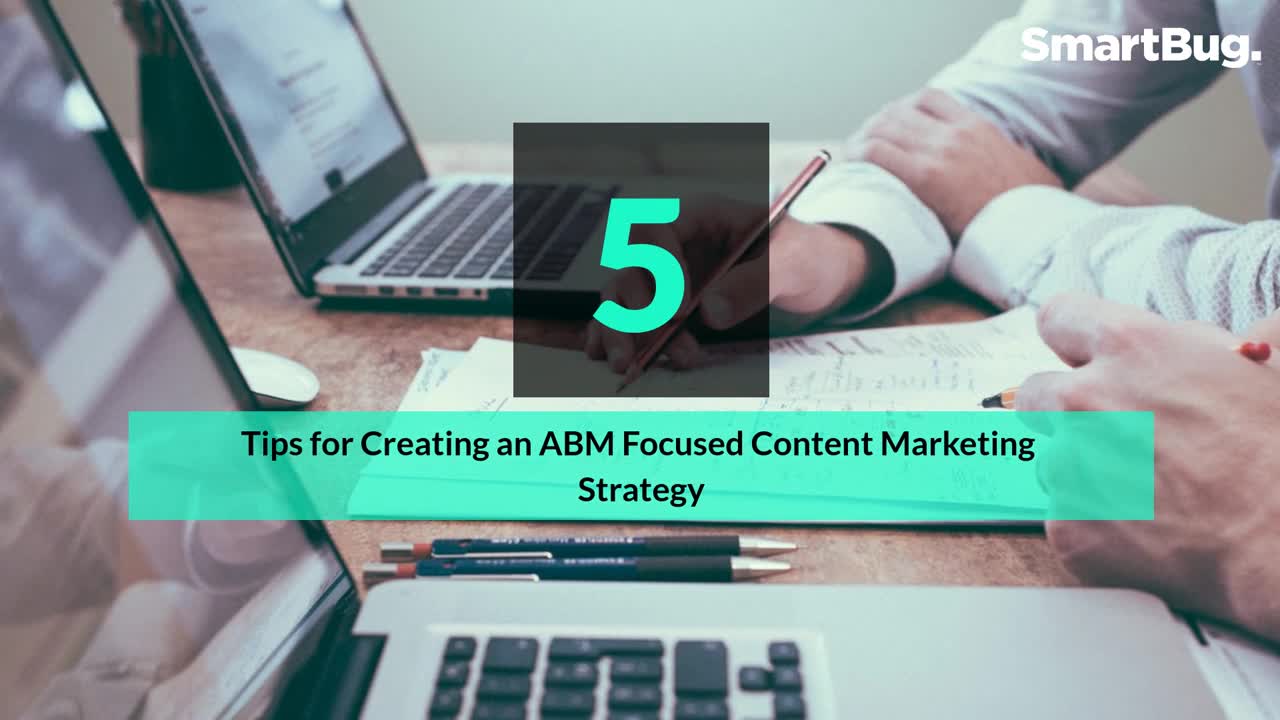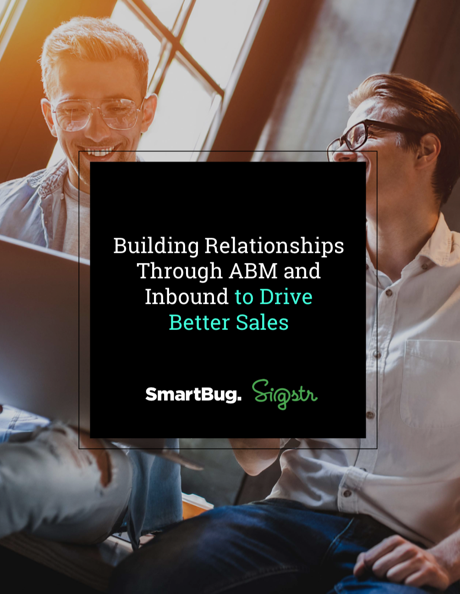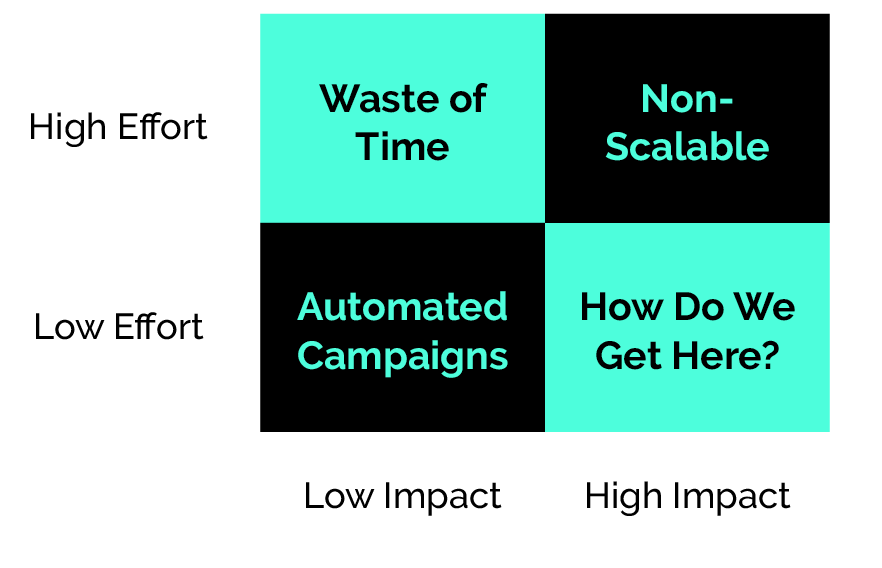
Building Relationships Through ABM and Inbound to Drive Better Sales
It's time to deliver valuable, relevant content and nurture targeted relationships with ABM. In this e-book, we’ll walk you through how to weave ABM into your inbound strategy, how to scale with smart content and email strategy, how to align sales and marketing, and then top it all off with how you can measure and prove ROI.

Download a PDF version of this guide by filling out this form, or keep scrolling to learn more.

Chapters
Incorporating ABM into Your Inbound Strategy
Scaling with ABM
Sales and Marketing Alignment
Data, Reporting, and Revenue
Incorporating ABM into Your Inbound Strategy

ABM and inbound marketing complement each other nicely. Typically, inbound marketing champions creating rockstar content to pull in prospects, and ABM focuses on marketing to individual prospects and existing accounts—but both are about championing engagement. And according to a survey by DemandBase, 83 percent of companies said the main benefit of using ABM was that it increases engagement with their target accounts.
But before you dig into inbound’s approach to developing personas, you need to select the right accounts. Start by looking at your company’s current accounts with the highest MRR (monthly recurring revenue). Look at industry, location, company size, yearly revenue, profit margin, and so on to choose the types of accounts you want to go after. Then, start building personas.
Build Your Buyer Personas Around ABM
ABM and buyer personas go together like PB&J, wine and cheese, the internet and memes. When they work together, ABM and buyer personas help marketers understand the people within a specific account so you can create targeted messaging to provide leads with high-quality content specific to each stage of their unique Buyer’s Journey.
But wait, what are buyer personas? Buyer personas are fictional representations of your ideal customer profile. These are more than just descriptions of your buyer—personas tell you what customers are thinking when considering the problem that your product or service solves. Aligning your marketing message to each persona should help you attract similar buyers.
Most businesses have multiple buyer personas, and it’s crucial that your entire organization understand these personas because they’re key to content creation, product development, sales, and just about anything related to driving and retaining customers.
Together, ABM and buyer personas deliver more than just company names and job titles—they allow marketers to work hand-in-hand with sales to develop persona-based journey maps. With this method, buyers for each account become the centerpiece of your ABM program. This provides marketers with a better opportunity for supporting the sales process because they understand a buyer’s goals, interests, and perspectives.
People are over being sold to—they want education and value. And this is where ABM shines, by delivering valuable content to build better relationships with target accounts without pushing products or services.
87% of the world’s best sales and marketing people believe that relationships are absolutely critical to their revenue success.
Nail Down Your Target Accounts with Data
Would you believe that as many as 20 people can be involved in the average B2B purchase decision? Experience tells us that the more people involved, the less likely a deal will close—and this is where ABM changes the game. Here are four steps from Sigstr for tackling ABM:
1. Dig into Your Data
To find your target accounts, sales and marketing need to work together to look at data, including prospect industry, company size, location, and annual revenue. Then, they need to dig into digital factors such as market influence, likelihood of repeat purchase, and expected profit margin. With your buyer personas in mind and data at your fingertips, select your target accounts.
2. Research, Research, Research
Now that you have your target accounts, it’s time to research and strategize. The goal of ABM here is to treat these companies like large, organization-level personas by using your buyer personas to build company profiles—but on a larger scale. This step is usually manual and requires a lot of sleuthing (think: LinkedIn), but becoming familiar with company structure, key players, and more can help you better market your product or service.
3. Create Kickass, Targeted Content
Now that you have your data-backed accounts in hand and are familiar with the key stakeholders, it’s time to talk content. Look at the content you have, the gaps that exist, and the content you need to create so you will have a holistic approach. You need to deliver specific solutions to hit the company’s unique pain points, so set up a content matrix to map messaging throughout the Buyer’s Journey.
Pro Tip:
Make your content as personalized as possible— but don’t panic! Not all of your content has to be created from scratch. In fact, you can work smarter, not harder by repurposing existing content. Not only will this approach let you scale faster, but it will also let you easily address the pain points of your key accounts and stakeholders.
4. Choose Your Channels
Content is king—but if the king happens to find himself in the Bermuda Triangle never to be seen again, is he really king? If the right people aren’t seeing your content on the right channels, your efforts are going nowhere fast. Figure out where your prospects are and what social channels and digital spaces they use online. According to the Pew Research Center, roughly 70 percent of Americans use social media, and Facebook still reigns supreme. LinkedIn, Instagram, and Twitter are all solid social platforms as well, and if your prospects are using them, you should be, too.
If the right people aren’t seeing your content on the right channels, your efforts are going nowhere fast.
ABM and Your Content Marketing Strategy
ABM challenges marketers to flip the funnel by identifying target accounts and building a plan to directly engage those accounts before and after they become customers. Here are some go-to tips for an ABM-focused content marketing strategy.
Personalize Sales Enablement Content
Data from McKinsey & Company shows that personalization can reduce acquisition costs by as much as 50 percent and increase revenue as much as 15 percent—so give prospects that personal touch when conducting sales outreach. One example is to sync with marketing and include custom fields or personalization tokens for email outreach or downloadable offers. (More on this later!)
Tailor Your User’s Web Experience
Given the hyper-focused nature of ABM, it’s critical that ABM programs deliver content that drives conversion. Personalizing landing or webpages are one effective tactic for doing this. B2B marketers should create targeted, account-specific landing pages that display custom copy, images, offers, and forms depending on the person or target account that is visiting the page.
Mention Target Accounts in Your Blog and Social Content
Blogging should be an important part of your B2B marketing strategy. Consider working mentions of your target accounts into blog content to build rapport. In order to continue to stay top of mind, mention your target account brands on social, too. It’s all about delivering content in context—across multiple channels.
Given the hyper-focused nature of ABM, it’s critical that ABM programs deliver content that drives conversion.
Generate Content Focused on Booking a Meeting
While marketing content is often aimed at generating leads, sales content is focused on helping sales teams generate a meeting or call with a prospect—but ABM only works when sales and marketing are working together to help build non-digital relationships with target accounts. Try offering a free consultation or evaluation.
Choose the Right ABM Technology
ABM is not like other traditional marketing tactics. Effectively implementing ABM is a long-term investment and is resource intensive. Leveraging ABM technologies and tools can help alleviate some of the burden and facilitate your ABM strategy.
Resources
Scaling with ABM

With the average B2B buying committee jumping from 5.4 people to 6.8 people over the past few years, Sigstr saw its 600 accounts add an additional 840 people to the account-based sales and marketing cycle. That is a huge amount of people to market to, and each and every one of them matter for making a sale.
Marketers obsess over the smallest of website language, the words used in emails and tweets, event strategy and follow-up campaigns, swag and messaging—but ultimately, those things go unnoticed. What matters in the long run is the overall feeling you’re able to create when you demonstrate that you care about every single individual through a beautifully crafted ABM campaign. This is why, as buying committees scale, your ABM content has to scale with them to create an indelible brand impression.

For marketers, the biggest problem with scaling is resourcing. High-effort ABM that is also high-impact is not scalable, and low-effort ABM is low-impact because it's usually automated. Marketers ultimately seek out the low-effort, high-impact ABM holy grail—but how do you get there?

Most teams start their ABM journey with ABM “lite”, according to ITSMA, probably because of bandwidth and spending constraints. But strategic ABM—which requires a meaningful investment of time and money—is where the magic happens, and you should spend as much time there as possible. The more time you spend with strategic ABM, the more you’ll develop the skills necessary to scale your efforts with super-targeted, highly orchestrated campaigns.
Here are a few tips for refining your strategic ABM efforts:
Data, Data, and More Data
Digging into the firmographics, initiatives, and brand values of your target accounts requires a lot of hard, manual work. Understanding the pain points and passion points of everyone involved in each account requires even more hard work. For Sigstr, the key is taking two hours every month to enrich accounts and contact data with information that then informs personalized campaigns and helps the sales team create more engaging communications.
With enough legwork, you can uncover important details about each member of the buying team, including:
- Preferences
- Tactics
- Business style
- Priorities
- Prejudices
Additionally, it’s important to know how each member of the buying team relates to one another. Who reports to whom? Who manages the budget? Who are the influencers, enablers, blockers, and champions?
Master the Content Matrix
According to B2B Marketing, 84 percent of all buying committees have a “champion” and that champion holds 59 percent of the purchasing influence over the buying committee. These champions cite “content, research, and expertise” as their primary considerations when making a purchase—and a full 97 percent of those same champions said they’ve already made their purchasing decision before the committee is even formed.
That means that, by the time you get to the pitch, you really just have to make the buying committee believe that the decision they’ve already made is the right one. But how do you get them to the right decision in the first place? You need to provide them with a well-tailored content experience that directly addresses each of their needs and roles.
Email Personalization
If you’re conceptualizing how to create a tailored content experience, start with your email strategy. Every organization uses email, and most send thousands of emails every single day. Why not leverage that real estate?
According to Sangram Vajre, Co-Founder and Chief Evangelist at Terminus, optimizing your email signature can be an incredibly powerful and game-changing ABM tool for how people think about and perceive your brand. With so many people involved in the decision-making process, Vajre says, “They’re all not going to download an e-book, so how are they going to know more about your brand? They’re probably going to look at your email signature and that becomes the first place from a brand identity perspective.”
After all, Vajre says, “People drive relationships and relationships drive business—and all of that is predicated on the fact that people know what your brand stands for.”
Before getting started with an ABM email signature customization tool like Sigstr, it’s important to have the account’s personas and sales stage tracked in your CRM so you can intelligently deliver targeted content to your key decision makers.
Corporate Emails
If the target account isn’t quite ready for a demo or the next step, the sales team can insert a call to action (CTA) in email communications that requires less commitment, such as signing up for a newsletter or weekly content update. That strategy allows the marketing team to continue nurturing the account until the contact is ready for the next step with sales.
Personal Emails
If you haven’t considered leveraging your email signature for ABM, we’ve got news for you: It’s the hottest, best spot to tackle ABM.
Although it’s important to establish a “one-to-many” email marketing strategy, you also need to emphasize a “one-to-one” email strategy. When sales, or any member from your team, reaches out to a top target, use the employee’s email signature as an opportunity to add a personalized CTA relevant to the recipient. For example, Sigstr can intelligently and automatically insert a CTA banner in any email that any employee sends to a target account’s domain—as long as you have your persona and sales stage locked down.
Although it’s important to establish a “one-to- many” email marketing strategy, you also need to emphasize a “one-to-one” email strategy.
Make Your Content Smarter
Smart content is an innovative and intuitive approach that alters the content displayed in a module—on a website form or in an email, for example—depending on who is viewing the content. Think about Amazon’s suggestion engine and how it nudges you to buy things based on what you’ve already purchased. If you recently purchased a cookie sheet and some cookie cutters, Amazon might suggest you buy the newest cookie cookbook on the market. That, friends, is powerful smart content at work making sales.
Speaking of cookies, that’s exactly how HubSpot’s smart content engine works. HubSpot looks for cookies and analyzes browser settings to assess preferred language, device type, and IP address for location. If the engine picks something up, smart content will deliver custom content. Otherwise, your default content will be shown to the visitor.
With HubSpot’s smart content feature, you can alter the content based on the following factors:
-
Lifecycle stage: If you’re keeping up with where your contacts are in the Buyer’s Journey, you can deliver them smart content catered to their unique stage.
-
Device type: Would you believe that 48.2 percent of all webpage views worldwide happen on mobile? With smart content, you can display specific content based on device type—mobile, tablet, or desktop.
-
Country: Country is determined by the IP address of the user, allowing you to display unique or specific content.
-
Referral source: Deliver your web visitors smart content based on how they landed on your site.
-
Preferred language: Imagine being able to show content based on the language of the user’s browser. Smart content does that!
-
Contact list membership: You can show a contact in your HubSpot database certain content depending on what lists they belong to.
It’s important to remember that the closer an account is to the top of the funnel, or “beginning” of the flywheel, the more general your content can be, but as you get to know the account better, you should make sure they’re noted at the correct stage of the Buyer’s Journey so they’re receiving targeted, smart content.
Pro Tip:
Mobile has become the preferred method for nearly half of all web users, and cookies are unsurprisingly unreliable on mobile, which probably leaves you wondering about the future of smart content. In fact, according to more than 60 percent of marketers, tracking cookies will no longer be relevant for the majority of digital marketing efforts in the next few years. Like any good marketing strategy, you can’t put all of your eggs in one smart content-fueled basket. Diversify your content with a mixture of static, dynamic, and conversational pieces, and you’ll create a solid content ecosystem.
Get Social
According to Terminus, companies that use ABM generate a mind-blowing 208 percent more revenue—imagine being able to expand that revenue reach even further!
ABM is about building relationships and trust with the right people, which makes social media the perfect partner in the process. Once you have buyer personas in mind, you can use social media to:
- Identify key decision makers
- Identify their pain points
- Deliver them targeted content focused on their pain points
- Guide them into making a purchase/decision
Master the Art of Social for ABM
Start by creating a Twitter monitoring list comprised of all of the key decision makers at your target accounts. This will let you quickly access their accounts and see what they’re tweeting about so you can feed them meaningful, relevant content.
If you’re not sure where to start when tracking people down, head over to the target account LinkedIn page and follow these instructions to find company employees. With that list in hand, you’ll be able to easily search for key stakeholders on any number of social platforms.
Then, spend time listening and collecting information about stakeholders, such as their interests and pain points. This strategy will help you flesh out your personas and beef up your CRM with pertinent information that can help the sales team when it comes to the final stages of the purchasing cycle.
Some things to listen for include:
- What they complain about
- Who they follow and with whom they interact
- Hashtags they’re using
- The type of content they engage with and share
- What their customers are saying about their company, support, and services/products
MarTech Pro Tip:
MarTech companies like Buffer, Hootsuite, and HubSpot make it easy to monitor any Twitter streams you create by pulling in hashtags, brand mentions, and more. Head over to HubSpot inbox streams to view all interactions and conversations across all of the social channels you have connected. This is ideal for finding and jumping into relevant conversations.
Get the Right Content to the Right People
Not only are your personas spending time on social media (which means that you should too), but more than half of B2B buyers use social media to inform their purchase decisions. This makes social an ideal place to share the content your team has spent time creating and curating.
Don’t simply share a link with boilerplate body copy—write a thoughtful, personalized post as if you are speaking directly to your target buyers. It’s not always necessary to include a link either. If you enjoy writing, craft a story that resonates with your personas. This works particularly well when shared on personal LinkedIn profiles. Into video? Make quick, personal videos using your smartphone.
Be Effective by Making It Personal
Speaking of being personal on social media, following and interacting with target accounts from your company’s social media channels is great, but making authentic connections is more effective when you’re using your personal accounts.
That being said, now would be a great time to update and optimize your personal social profiles. Update that LinkedIn bio, customize your LinkedIn URL, revamp your Twitter bio, and don’t forget to make it clear from a single visit to your profile how you can help your ideal buyer personas—and why they should follow you.
Pro Tip:
If you’re serious about using social media for ABM, create a paid social strategy to support your ABM efforts—but make sure your strategy is goal-focused. LinkedIn offers account targeting where you can target a specific list of people or even a list of companies with additional filters (such as seniority and job title) layered over them. Terminus is another platform that can help you identify and engage your target accounts.
The Power of Premium Content
All of the data and insight into your accounts and their buying teams in the world are only valuable if you actually use them—at the right time with the right content deliverables and engagement. After all, “every sales process is the sum of its engagements.” The more you pour into creating relevant, meaningful content for your prospects, the more you increase the quality and volume of your engagements, which means more sales.
In fact, if the buying committee members or champion are in the C-suite, ABM actually increases the likelihood of reaching these execs, according to a report by SiriusDecisions. Not only do 30 percent of marketers say that ABM helped them reach C-level executives, but those surveyed also reported an incredible boost in target engagement.
Although every targeted, relevant piece of content you create is effective for ABM, premium content in particular can play an impactful role. Beyond email marketing and blog articles, here are some ideas for premium content:
- E-books
- Webinars
- Whitepapers
- Videos
- Infographics
- Surveys/quizzes
- Calculator
- Podcasts
The key to succeeding at premium content is to diversify your deliverables so that you have the right piece of content for the right stakeholder. Although one member of the buying team might want to read a 20-page e-book, another stakeholder might prefer to watch a two-minute video featuring much of the same content.
According to a CEB survey, individual stakeholders who believed content was tailored to their specific needs were 40 percent more willing to make a purchase than key buyers who didn’t feel like the content was personalized. But creating 100 percent personalized content for every persona and account is not scalable—and you don’t have to create content from scratch.
When developing your premium content, focus on the content you already have in your content library and get creative at repurposing. For example, turn a data-packed webinar into an infographic or parlay an e-book into a pillar page on your site. Or rewrite a white paper intro and tweak some stats to cater to a specific prospect.
Although customizing content is one of the biggest challenges marketers cite in executing their ABM strategies, it doesn’t have to be! Take a look at these personalization and customization strategies and find the one that makes the most sense for your ABM strategy from a resourcing and budgeting perspective:
- 100 percent personalized: Content created for a specific account and persona
- Highly personalized: Content created for a single account’s multiple personas
- Customized: Lightly adapting existing content for one account
If you’re hitting prospects at the top of the funnel, you can also focus on the following broader strategies:
- Industry-specific: Content focused on one specific industry
- Multi-sector: Content targeted at a cluster of related markets, such as insurance and FinTech
- Highly customized: Heavily adapting existing content for one account
- Generic: Relevant content geared toward all target accounts
Once you have a library of quality, relevant content, you can start integrating each piece into your targeted email marketing, email signature, and social media strategies.
Technologies to Support Your ABM Efforts
Before you start investing in a technology stack to support your ABM efforts, take one more step back and make sure your target accounts have FIRE: fit, intent, relationships, and engagement.
- Fit: Make sure the target account is a good fit across factors such as firmographics and technographics.
- Intent: Intent data delivers insight in to how a business is surging on specific topics tied to products and services. Basically, it tells you when a business is looking into specific brands.
- Relationships: You need to understand the operational relationships of your target accounts, including how people on the buying committee engage and interact with one another. Finding out more about this can be as simple as picking up the phone and calling someone or sleuthing on LinkedIn.
- Engagement: Are the right buyer personas at your target accounts engaging with your content? What does that engagement look like?
Then, to help you with everything from digging into data about your buyer accounts and managing that information to communicating with key stakeholders and running ads, we have some recommendations for ABM-boosting technologies.
CRM
The data and utility of your CRM or account management system are critical to managing account details and communication, but your CRM can also help you determine the best accounts to prioritize and help you map essential stakeholders and past account relationships. Some of the best CRMs for supporting ABM are Salesforce, HubSpot CRM, and Nutshell—but whichever CRM you decide to use, these features are incredibly valuable for ABM:
- Ability to match leads to accounts
- Lead and account-level reporting
- Built-in account insights
- Integrations or an open API to connect with other key ABM platforms
Data Enrichment
When building out key buyer profiles, the more data you have, the better you’ll be able to target content and create meaningful engagement. A few sources for building out your stakeholder profiles include:
- Some platforms are better suited toward startups,small organizations, or enterprise data.
- Most platforms are priced around the volume of contacts and data calls.
- Accuracy varies—even on the best of these platforms—so validation by your sales team is important.
Social Media
Social selling is a crucial aspect of ABM. All major social media platforms that your target accounts use will be valuable, and you can make those platforms easier to manage and more effective with the following technologies:
- HubSpot Social Media: Monitor, publish, and engage with critical social channels. This also includes a handy extension that’s great for a busy sales rep. The tool is only available when you purchase the platform.
- Hootsuite: With this stand-alone social management platform, there is no need to buy a comprehensive marketing or sales solution to get the full functionality. It’s also great for an enterprise, because it includes workflows to help stay compliant and on brand.
- LinkedIn Sales Navigator: With this technology,you can research and identify target accounts, while taking advantage of some neat features built in for sharing sales content and showing you people in your network that could help make an introduction to key contacts.
If we’ve thoroughly whetted your appetite on ABM-boosting technologies and you want more, check out our list of 61 options, including technologies for account mapping, predictive analytics, sales enablement, marketing automation, integrations, and more.
Resources
Sales and Marketing Alignment

We’ve talked a lot about technology and tactics and strategy, but ABM is all about people, and internally you need to have the right people working together and fully bought in to succeed. More than ever, marketing is involved throughout the entire sales process, supporting the sales team, driving engagement, and helping secure sales.
However, only 60 percent of companies in a DemandBase report said they’re even “somewhat aligned” with sales. The key to aligning marketing and sales? Account-based marketing!
The simple truth is that organizations that leverage ABM are more tightly aligned than those that don’t. According to Bizible, marketers who use ABM are 42 percent more likely to report alignment with their sales team compared to those not using ABM. In a report by the Content Marketing Institute and MarketingProfs, companies with properly aligned sales and marketing teams reported that ABM delivers customer retention rates that are 36 percent higher, along with 38 percent more sales wins.
Tactics for Alignment
So what’s the secret? ABM forces sales and marketing teams to not only speak the same language, but to also collaborate on key ABM tactics and align on sales initiatives. According to Chris Souza of Leanplum at the 2018 Optimizing ABM Impact event, the top five alignment tactics you need are:
- Make everything shareable.
- Use common datasets.
- Focus on the value of simplicity and scalable data.
- Set realistic expectations.
- Slow down—trust takes time to build but only seconds to lose.
In a SiriusDecisions study, B2B organizations with closely aligned sales and marketing saw revenues increase 24 percent faster in a three-year period compared to organizations where the teams were siloed. Those same companies also increased their profits 27 percent faster during that same period.
So, what can sales and marketing do to improve their ABM program performance and strategically build, develop, and leverage business relationships at scale to impact the bottom line?
B2B organizations with sales and marketing alignment saw profits increase 27 percent faster than companies with siloed teams.
What Sales Can Do
Aligning with marketing has always been important for the sales team’s success, but with ABM, it’s more than just important—it’s critical. Understand which prospects marketing is currently engaging and determine if there are opportunities for handoffs, follow-ups, or more personal outreach.
When sales and marketing are aligned with ABM, they become 67 percent better at closing deals, according to a joint Marketo and ReachForce study. Don’t just commit to cold touches— make the most of the work marketing has already done to move the relationship forward in a meaningful way.
What Marketing Can Do
If sales needs to work with marketing, marketing needs to meet sales where they are, too. Ask whom the sales team is reaching out to, what content they’re sending, and what you can do as a marketer to support their efforts. How can you make their conversations easier, more fluid, and more impactful?
If sales needs more information about an account or its contacts, do your best to help them find what they’re looking for—and personalize or customize content if need be—so they can have the most meaningful engagements possible. This lets sales focus less on education and more on closing sales. In fact, ABM helps reduce up to 50 percent of the time sales spends on analyzing prospects sent over by marketing—which, historically, has caused sales to ignore 50 percent of marketing leads!
Here are four more ways that marketers can enable the sales team to succeed:
-
Focus on individuals, not the group: Although you’re selling to a company, actual human beings are doing the buying and each of those humans has unique pain points and needs. Don’t lose track of the group’s needs, but be prepared to support sales by personalizing and developing content that each individual can identify with.
-
Know your champion: As we discussed in Chapter 2, the champion holds the majority of the decision-making power of the buying group, so it’s important to build trust with your champion through targeted content. In fact, build trust and deliver the right content, and your champion will likely end up sharing your content and locking in the entire committee on the sale.
-
Master content and timing: You need persona-based content to master account- based sales and marketing, because different industries and personas have different ways of speaking—and how they define success also varies. Set up a content matrix with content and deliverables for your target personas and prospects, and then make sure you can deliver the content at the right time.
-
Don’t be afraid to emote: Would you believe that 95 percent of purchasing decisions are made subconsciously? This might be why 97 percent of B2B marketers say that their decision has been made before the buying committee is even formed. People want to buy from brands they trust and enjoy, so be the brand they can identify with—and help convince them that the decision they’ve already made is the right one.
Data, Reporting, and Revenue

Now that your teams are aligned and you have the most promising target accounts and thoughtfully crafted content, how do you build metrics for evaluating your efforts and successes? Let’s take a look at the value of coverage, engagement, reach, impact, revenue, and ROI.
Coverage
Account coverage measures two things: how many accounts you’re reaching and whom you’ve actually reached. This is a key metric to track because it can serve as the base of your strategy. It’s what you will use to align your marketing efforts to the actual personas and to ensure the right message reaches the right account contacts. In order to properly get a read on your account coverage, look at where your contacts are within the Buyer’s Journey, how many of your contacts have been engaged, and which contacts belong to which account.
Engagement
Once you know the makeup of a current account, it’s time to answer every marketer’s favorite question: Are your leads engaged? Conversion metrics will be important for determining engagement, and you’ll need to ensure that your tracking mechanisms— whether Google Analytics, your marketing automation platform, or a third-party service—are in place and working properly. It’s not a warm and fuzzy feeling when you push a campaign out the door and later realize you have no way of knowing what part of it did or didn’t work. And when it comes to ABM, you’ll definitely need to know how engaged your prospects are in order to take the appropriate next steps.
Reach
Sure, your prospects may be engaged, but are you reaching your intended targets? Although having an ABM campaign with a lot of activity feels good, it becomes bittersweet if you don’t reach the right prospects. Tracking reach can further determine whether your efforts were worthwhile and help you plan or adjust future campaigns. It also helps to know what channels are generating the most interactions among your targets so that you can reach those prospects more quickly in the future.
Impact and Influence
Now it’s time to determine which activities really impacted your prospects’ purchasing journeys. You’re already putting together a solid, modern ABM campaign. Why use outdated batch-and-blast tactics? Determine what action(s) will effectively move your prospects down the funnel before you execute a campaign. Are engaged contacts more likely to speak to sales or sign up for a demo after a webinar? Or maybe you have an interactive quiz that has been killing it lately.
Take metrics one step further by measuring the outcomes of your ABM campaigns against some of your other campaigns or established benchmarks. Did prospects in your ABM campaign close more quickly? What was the deal size? Like all things ABM, this requires sales and marketing to align toward a common, ROI-impacting goal.
Revenue
Although technology gives us the ability to quickly reach across the globe and connect with people in an instant, it’s up to us to meaningfully build and nurture those relationships. Crafting authentic relationships is paramount in ABM, because these relationships directly impact revenue.
According to research by Sigstr and Heinz Marketing, more than 80 percent of sales and marketing professionals surveyed—and nearly 90 percent of top-performing companies—agree that developing authentic relationships is very important for generating revenue. In fact, 96 percent of all sales and marketing professionals in that same study agreed that “a strong relationship with key stakeholders plays a major role in the outcome of a sale.”
ROI
If your campaigns are costing a good deal of time and money but are only turning out a few sales, you may want to tweak a few things. For example, if the bulk of your campaign is effective, would it be just as effective if you reduced your ad spend? Or, perhaps, you have an internal thought leader who can reach the audience just as well as the speaker you contracted?
Tracking ROI can also prove to the right people that your ABM efforts are working and fueling growth. It’s just another feather in your cap and leads to buy-in for future campaigns. Prove ROI, and you could be demonstrating the need for new technology to streamline your campaigns, meaning that the shiny piece of MarTech you’ve been after for months might finally be within reach.
Conclusion
ABM offers a new, collaborative, and more meaningful approach to marketing and sales than ever before. At the end of the day, in order for your ABM program to succeed, you need to use your human brain and commit to human engagement and communication to build valuable relationships that will turn into sales.
Sigstr’s VP of Marketing Justin Keller hit it on the head when he said:
“We spend so much time building out lead scoring frameworks trying to understand the buying behaviors, firmographic, and demographic traits we really like to engage with. But at the end of the day, they don’t matter in a relationship-based sale. It’s really about how you’re communicating and engaging with the human. Sure, lead scores are helpful but measuring relationships is what I think is going to become really important for marketers.”
Download the Guide
Simply fill out this form to receive a PDF version of our guide.




